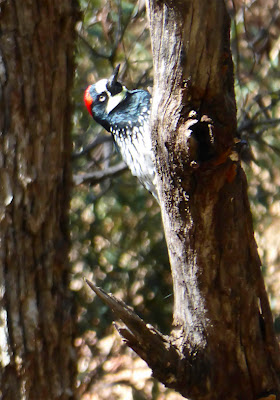In Costa Rica along the crest of the Cordillera of Tilarán, is a world of mist and greenery: the cloud forest of Monteverde. Trade winds from the Atlantic bring a steady flow of clouds across the mountain ridges, nourishing an astonishing forest, draped in ferns, moss and orchids. Resplendent Quetzals spend part of each year in this misty realm.
Santa Elena Cloud Forest Reserve, within the Bosque Eterno
(Photos by Narca)
The original Monteverde Cloud Forest Preserve has been augmented by the Bosque Eterno de los Niños – the Children's Eternal Rainforest. The Bosque Eterno was conceived by schoolchildren in Sweden; when I used to go regularly to Costa Rica, fund-raising for the Bosque Eterno was just getting off the ground. It succeeded, and now a magnificent reserve is the result.
Years ago at the entrance to Monteverde Cloud Forest Reserve, a hummingbird gallery, complete with feeders, was established by local folks, including Patricia and Michael Fogden. Today that gallery teems with a truly dazzling array of hummingbirds. When we were there a week or two ago, many, many hummers of eight species were buzzing around the feeders, enchanting everyone who ventured onto the gallery grounds. Here are a few photos for your enjoyment!
The big Green Hermits come only infrequently to feeders. Most of the time they are deep in the forest, pollinating plants like
Heliconia.
Green Hermit
Tiny Coppery-headed Emeralds used to be scarce at the Monteverde feeders, so I was surprised to see several of them the day we were there. Males blend darkly into the shadows, until they catch the light just right... then, a glorious flash of intense green! This emerald is a Costa Rican endemic, mostly on the Caribbean slope, although it spills over onto the Pacific slope in this region. Like many other tropical hummingbirds, the males gather in small breeding leks and call to attract receptive females.
A male Coppery-headed Emerald goes from subtle...
... to sublime!
The female emeralds are much more modestly dressed.
A female Coppery-headed Emerald shows her pink-based lower bill.
Another of Monteverde's smaller hummingbirds is the Magenta-throated Woodstar, endemic to Costa Rica and western Panama. These buzz around, tails often raised, creating a distinctive wing-whir that lets you know they're in the neighborhood. Here's a challenge for you: the nest of this species has not yet been found and described... go for it!
A male Magenta-throated Woodstar
Rather larger is the Green-crowned Brilliant, here sporting the spotlights he uses to dazzle females. This brilliant is a creature of the high, wet mountains, and it ranges as far south as Ecuador (another country that boasts
fabulous hummingbirds!)
Male Green-crowned Brilliant...
...and a lovely female brilliant!
Purple-throated Mountaingems are perhaps the most abundant species at Monteverde's feeders. The female is a bright buffy-rufous below and sports a strong mask. Like other hummers, these are VIPs: Very Important Pollinators.
Female Purple-throated Mountaingem
And just in case you're thinking that the species is misnamed...
...the gorgeous male mountaingem is a show-stealer!
Another beauty which seems to me more frequent now at the hummingbird gallery's feeders is the Green Violetear. This violetear occupies highlands from Mexico, all the way down into the Andes of Bolivia. Although its range overlaps that of the other two violetears (Sparkling and Brown), the Green prefers wetter, higher forests, and so is right at home in Monteverde.
Two views of a Green Violetear
Another hummer with a fairly large range (from southern Mexico to Panama) is the little Stripe-tailed Hummingbird. Those bright rufous wing patches are a good field mark. They are quite regular at the Monteverde feeders and in the cloud forest.
Stripe-tailed Hummingbird
One of the most impressive hummers in Costa Rica is the enormous Violet Sabrewing––at 6" long, the biggest hummingbird away from South America. For comparison, our Magnificents are 5.25". Just look at that scintillating deep blue-violet! The sabrewing's range is similar to the Stripe-tailed's: southern Mexico to western Panama. This hummer also feeds often at
Heliconia, and the males, like the tiny Coppery-headed Emerald males and the Green Hermits, also gather in leks to "sing" for the females.
Violet Sabrewing
A sudden dazzle announces the arrival of a stunning Violet Sabrewing!
Hummingbirds live only in the Americas. What a treasure they are!









































